

Boat-hitchhiking is basically the height of sustainable and adventure travel. This way of travelling is still largely unknown and can seem pretty complicated. Thanks to my own experience as a boat-hitchhiker, and the help of many other long-term travellers who are experts on the subject, I’ve managed to write this information-packed article. It thoroughly explains everything you need to know about travelling around the world by boat-hitchhiking.
Just this once, all the statistical figures presented in this article don’t come from our own surveys, but from those of the world benchmark of sailing, Jimmy Cornell. He’s carried out remarkable research for more than 10 years by directly questioning ports around the world, as well as his vast number of readers from each and every country.
Boat-hitchhiking generally involves getting in touch with a boat owner or skipper who’ll agree to take you on board from a one day trip to a several week trip.
You can do it alone or in a group, be experienced or not at all.
You can find all kinds of boats to board: huge ones, big or small ones, with a motor or with sails. However, boat-hitchhiking is almost always done on the latter.
In the vast majority of cases, boat-hitchhikers are expected to help out on deck or do a particular job. On sailing boats, everyone who gets on board is a crew member.
Even though it’s a pretty low-cost way to travel, it’s usually not free. In any case, it’s the most environmentally friendly way to see the world and it’s always full of great adventures.


Boat-hitchhiking doesn’t really look like this
More and more globetrotters are looking to reduce their trips’ impact on the environment. As seen in our article on how to limit your ecological footprint whilst travelling, taking less flights is by far the most effective way. But the alternatives to flying across seas and oceans are limited.
The best alternative is boat-hitchhiking. A sailing boat primarily moves with the wind. The motor is still occasionally used when there’s not even a breath of air, for charging the batteries or for entering and exiting ports. Nonetheless, it barely pollutes. A cargo ship, on the other hand, pollutes a lot. But, it’s used to transport goods, so it doesn’t really matter if there are passengers aboard, as it’ll leave with or without them. So, it’s thought that this is also a clean way to travel.
Nowadays, modern modes of transport are so quick. For example, by plane, you’re catapulted from one universe to another in the blink of an eye. However, boats move slowly. A fast sailing boat moves at seven or eight knots (8 to 9 mph or 13 to 15 km/h) on average. Travel is no longer “a pause in the trip”, it’s the trip itself. After a few days, your personal relationship to time and distance changes.
And then, after taking several weeks to reach your destination, the arrival is like an adventure that comes to an end, an achievement that has something magical about it. It feels like a well-deserved reward, and that’s a really good feeling.
In everyday life, and even when travelling, people are usually caught up being active or feeling guilty if they’re inactive. On a boat, there’s action, but you also have a lot of time for yourself. It’s a good opportunity to read, think, meditate, take a step back and reflect on your life. These moments are rare and precious and often do you a lot of good.
A boat (and especially a sailing boat) isn’t just a means of transport. Sailing is an adventure unlike anything else.
Finding yourself on a boat in the middle of the sea – miles away from land, surrounded solely by water as far as the eye can see, facing sea and wind conditions that aren’t always easy to deal with – isn’t a trivial experience. Out there, many discover an incredible sense of freedom.
Some people imagine that you just hang around on a sailing boat, but there are always some adjustments to be made to optimise sailing. If you take an interest in how it works, you’ll discover an exciting world. Skippers are often very happy to share their knowledge with curious boat-hitchhikers who want to learn.
Living in a confined space, as a community and a sailing crew, is also an extraordinary human experience.
Finally, there are loads of opportunities to fish and that’s one of life’s simple pleasures: to eat food you’ve caught and prepared yourself.
Watch the sky for 10 minutes and you’ll see shooting stars.Kris talking about his Atlantic crossing
Light pollution extends much further than cities and obscures the sky way more than you could imagine. In Europe, for example, even at the heart of nature, there isn’t a single place without any light pollution, except for a few small areas in the far north of Scandinavia. Far from the coast, sailing on the open sea, you see the most beautiful night skies in the world.


Earth at night from space
Photo by astronaut Thomas Pesquet
Travelling by boat often takes a long time, especially ocean crossings. You’ll have a hard time organising such a trip during a few weeks’ holiday. A long trip or a round-the-world (RTW) trip is the perfect opportunity to boat-hitchhike.
Boats around 10 metres long are pretty common in marinas. They can make short journeys on high seas for a few days, but they don’t have enough fuel capacity to cross oceans.
Big private luxury yachts can cross oceans, but that’s pretty rare. They usually have lots of staff, and the best chance of boarding one is to find a job on board.
Shipowners’ rules are extremely strict. Nowadays, whatever your arguments, it’s impossible to get on board a ship unplanned, even if you directly talk to the ship’s captain. They don’t hold the decision-making power to let a passenger board.
However, you can travel on a cargo ship as a passenger. A few cabins are often reserved for them. All you have to do is buy a ticket from an agency and complete some formalities. But, it’s expensive: from $90 to $115 (£70 to £85) per day of navigation.
Yet, we spoke to a few travellers who still managed to cross oceans for free on a cargo ship. Ludovic Hubler and Florence Renault are among them. They directly asked the managers of the companies. They convincingly explained their eco-friendly, hitchhiker way of travelling to them and also offered their skills: taking professional photos and videos for companies’ marketing departments. But this is easier said than done. Ludovic says it took him dozens of emails and refusals and at least one month of administrative paperwork.
It seems to be easier to get on a ferry for free. Their captains are subject to fewer rules than those of cargos. They’re difficult to meet directly, but it’s usually in their power to allow a boat-hitchhiker on board. Florence Renault has benefited from this many times..
Several travellers told us that they did it the same way as with cargo ships. They spoke to the company’s management and offered their skills on board in return for the price of the crossing (though not as paid employees). However, for a single crossing, a foreigner who doesn’t speak the language wouldn’t be of any use and it’d probably be illegal.
Terence Groos was able to offer his photography skills on a ferry between China and Korea. According to Florence Renault, coming up with another interesting idea like a concert, a kid’s workshop, a magic show or something else might have also worked.
On ferries, there’s also another option. More often than not, says Terrence, heavy goods vehicles pay a flat rate that doesn’t depend on the number of passengers. So, you could get into a truck before arriving at the port, and therefore get the crossing for free.
The number of boat-hitchhikers on motor yachts is purely anecdotal. When we talk about both-hitchhiking, in the vast majority of cases, it’s on long-distance sailing boats. Therefore, the rest of this article will focus on those.
In his major 2015 survey, Jimmy Cornell estimated that there were around 8,000 sailing boats undertaking a several-month or several-year trip in the world that year, in addition to all the sailing boats that just do short journeys.
Boat-hitchhikers are welcomed on board as crewmates. Don’t worry, you can be a crewmate without any sailing experience. In the rest of this article, we’ll tell you everything about the importance of the crewmate’s role, what exactly it consists of and all the details: from looking for a boat, to experience at sea and up to disembarkation.
According to Jimmy Cornell’s 2015 survey, the average length for the 2,508 boats (under 60 feet (18 metres)) that transited through Panama, Tahiti, Bermuda or the Azores in 2015 was 13.7 metres (45.3 feet). And, between 12% to 19% of the sailing boats on long voyages that passed through major hubs around the world were catamarans. The others were mainly monohulls.
Sailing boats embarking on a long crossing of several days or weeks don’t always have enough people on board to travel optimally. Sometimes, boat-hitchhikers or co-skippers are needed to complete the crew.
Nowadays, most boats that venture on long-distance trips are kitted out very nicely. They have satellite navigation systems, a radar and automatic alert systems. However, these tools aren’t foolproof. Making sure that there is always someone outside, in the cockpit, even in the middle of the night, is a basic safety rule at sea. This is particularly important for a long journey lasting several days or weeks.
Given that a single person can’t constantly be outside and needs to have a good sleep, enough people have to be on board to do shifts. Some sleep whilst at least one person outside, wide awake, monitors the navigation. We’re talking about watchkeeping. Taking an additional crew member on board means having an extra person who can help out with watchkeeping. In this way, the whole crew gets more sleep and will therefore be safer.
The crewmate’s role also includes helping out with manoeuvres, preparations before departure and all daily tasks. We’ll explain all of this in detail in the chapter “Crewmate’s Role”.
It’s usually sailing boat owners who take boat-hitchhikers on board. Around Europe, most are tourists on holiday for a few weeks. Further afield, those that you meet are mostly on long trips, like a RTW trip. Amongst them, there are all kinds of people: solo old sea dogs, groups of friends, but the majority of them are couples and families.
Jimmy Cornell mentions a 2016 survey, carried out by the tourism office of French Polynesia, on boats arriving in this area. 43% stated that they were doing a RTW trip, 46% a round Pacific trip and 11% a long, open-ended cruise. Concerning the size of the crew, 51% of the boats were run by a couple, 13% by three people, 20% by four people, 13% by a crew bigger than four and 10% by a single person. Overall, this survey shows that the fewer crew members there are, the better equipped and more efficient the boat.
A boat is expensive. At least $170,000 (£127,000) and more like $280,000 (£250,000) for a new, well-equipped sailing boat, and no less than $45,000 (£35,000) for a good deal. The vast majority of yacht owners are well-off people, often former business owners. However, those who live on their boat all the time or undertake lengthy trips have often invested all of their financial resources into their sailing boat. They’re not necessarily the “rich” ones.
Some aren’t very experienced sailors yet. So, it’s always a good idea to find out a little bit about their sailing experience, before carelessly jumping on board with anyone. See the section, “What to Check Before Stepping On Board”.
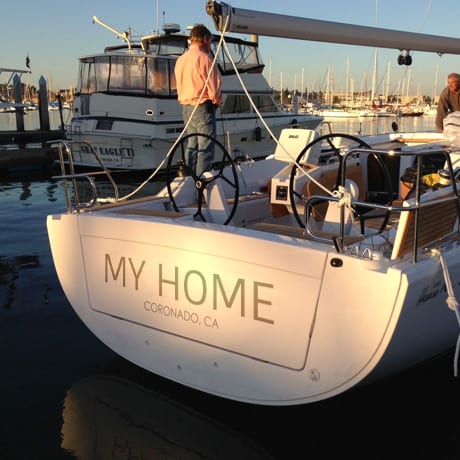

Their sailing boat is their home
Boat owners travel for enjoyment and often take the time to sightsee, anchor their boats, have an aperitif and crack out the BBQ.
Their boat is their house and they welcome you into their home. For most of them, the purchase was a hugely significant investment. Even if a boat-hitchhiker is a useful crew member who helps with the smooth running of the boat, many owners feel that taking you on board is like granting you a privilege. You take up space in the already limited living space of “their home”. So, as a guest, you must be on your best behaviour.
Although it’s not the norm, it’s not uncommon for them to ask boat-hitchhikers for a financial contribution to the trip, in addition to their share in the kitty. See the chapter, “How Much Does It Cost?”.
You also meet professional skippers whose job is to ferry sailing boats from one port to another on behalf of an owner or shipowner.
They also need crew members. Usually, they’re seasoned sailors, so you don’t have to worry about safety. They’re used to managing a crew, so it’s more likely that everything will run smoothly.
With them, you never pay more than your share in the kitty, it’s an official rule in their job.
Professionals wouldn’t agree to ferry dangerous boats. Therefore, in theory, they’re in good condition and sufficiently equipped. Generally speaking, they’re in a hurry and don’t have the time to hang around and make long tourist stopovers. Many are specifically hired to cross the Atlantic.
English is the most widely spoken language in the sailing world, which really gives an advantage to anglophone boat-hitchhikers.
According to Jimmy Cornell’s statistics – the world’s benchmark for sailing – here are the nationalities of all the yachts that called at the port of Las Palmas de Gran Canaria (one of the most important sailing hubs in the world and stopovers before the transatlantic passage):
French (199), British (163), German (98), American (62), Dutch (57), Swedish (49), Belgian (39), Norwegian (31)…
The main role of a crewmate, that is to say the main reason why they’re hired, is to take care of watchkeeping.
As mentioned above, on a sailing boat there must be someone outside (in the cockpit), all the time, even in the middle of the night (see the section, “Why Do Sailing Boats Need Crewmates?”).
During the watchkeeping period, you’re assigned to stay on the boat’s deck. When you’re watchkeeping, the rest of the crew is resting, sleeping or doing daily chores. Watchkeeping crew members take turns according to a schedule devised by the skipper before departure. In this way, everyone’s downtime and sleep time is evenly distributed.


Watchkeeping on a sailboat is a bit different
These days, all boats have an autopilot. It automatically steers the helm, without you even having to touch it. It works better than any human helmsman. Long-distance sailing boats (those that cross oceans) produce a lot of energy. They can keep the autopilot running all the time. Those that are more suited to just a few days of sailing offshore can run the autopilot for at least one whole night.
Many boat hitch hikers aim to cross oceans and they choose to get on board long-distance sailing boats to do so. So when you’re on watch, you don’t normally have to take the helm.
If the boat can’t be switched on to autopilot during the day, you really need to steer. A crewmate, even without any experience, can take the helm if conditions are favourable. If not, the skipper or an experienced crew member will take care of it.
Since crewmates usually don’t even need to steer, what are they good for?
Their main task is to keep a 360° watch (all around the boat). In other words, they need to make sure there’s no impending danger. That could be another sailing boat, a cargo ship, or anything that may be lurking in the water. It’s also a question of monitoring wind and sea (waves) conditions, making sure they stay stable. If there’s a minimal changel, the watchkeeper adjusts the direction on the autopilot by a few degrees, as will have been explained to them by the skipper.
The skipper always gives specific instructions like:
“If the wind speed and pressure shown on the anemometer increases to X knots, if the wind direction turns X degrees, if something is approaching, you call me and you wake me up if I’m sleeping”.


Dials outside show the direction and the wind force
During their watch, inexperienced crewmates are never allowed to make sail adjustments, and certainly shouldn’t do manoeuvres (like a change of tack) independently. This is the skipper’s role. Highly experienced crew members will only be allowed to do it if the skipper clearly agrees.
It’s the skipper who decides how it works.
There’s no set rule. It all depends on how many people there are, each person’s skills, the sea conditions, etc.
Often, the shifts are organised in a way so that they’re done as a team and there’s a rotating roster which means that you change partners. For conviviality, they try to make sure that at least one meal per day is shared all together.
An example of a fairly comfortable five-person rotating schedule
| 2am | 4am | 6am | 8am | 10am | 12pm | 2pm | 4pm | 6pm | 8pm | 10pm | 12am | 2am | 4am | 6am | 8am | 10am | 12pm | 2pm | 4pm | 6pm | 8pm | 10pm | 12am | 2am | ||||||||||||||||||||||||||
|---|---|---|---|---|---|---|---|---|---|---|---|---|---|---|---|---|---|---|---|---|---|---|---|---|---|---|---|---|---|---|---|---|---|---|---|---|---|---|---|---|---|---|---|---|---|---|---|---|---|---|
| Crewmate 1 | ||||||||||||||||||||||||||||||||||||||||||||||||||
| Crewmate 2 | ||||||||||||||||||||||||||||||||||||||||||||||||||
| Crewmate 3 | ||||||||||||||||||||||||||||||||||||||||||||||||||
| Crewmate 4 | ||||||||||||||||||||||||||||||||||||||||||||||||||
| Crewmate 5 |
The blue cells are watchkeeping shifts.
An example of a rather hard core three-person rotating schedule
| 2am | 4am | 6am | 8am | 10am | 12pm | 2pm | 4pm | 6pm | 8pm | 10pm | 12am | 2am | 4am | 6am | 8am | 10am | 12pm | 2pm | 4pm | 6pm | 8pm | 10pm | 12am | 2am | ||||||||||||||||||||||||||
|---|---|---|---|---|---|---|---|---|---|---|---|---|---|---|---|---|---|---|---|---|---|---|---|---|---|---|---|---|---|---|---|---|---|---|---|---|---|---|---|---|---|---|---|---|---|---|---|---|---|---|
| Crewmate 1 | ||||||||||||||||||||||||||||||||||||||||||||||||||
| Crewmate 2 | ||||||||||||||||||||||||||||||||||||||||||||||||||
| Crewmate 3 |
The blue cells are watchkeeping shifts.
As can be seen from these tables, you don’t get eight consecutive hours of sleep every night on a sailing boat during a crossing. You sleep in a more fragmented way. The natural biological rhythm is disrupted, but in the end the body adapts pretty quickly and it’s not so hard.
Each crew member takes care of daily tasks.
During navigation for long crossings, like with watchkeeping, the skipper usually goes for a schedule with rotating shifts. Each person takes turns cooking, washing up, cleaning, during or outside of watch shifts.
And what’s more, before departure, you also need to clean the outside of the boat, do the shopping, prepare menus…
A manoeuvre, such as changing a sail, tacking or even mooring to a pontoon, is much more easily done as a team.
The skipper is usually at the helm whilst he gives instructions to crewmates, each in their position on the deck. A crewmate with little experience will be appreciated at times like this. However, even a complete beginner, who’s been “well-briefed”, is very useful. This is your chance to really learn how to sail!
Travelling as a crew member on a sailing boat is economical, but very rarely free.
Most often, you have to pay your share of the kitty. But, it’s quite common for the person who takes you on board to ask for an additional contribution, which can vary a lot.
The kitty is mainly used to pay for food on board, but also gas and marina fees. Before departure, the skipper estimates how much money will be needed to cover these costs for the trip. Crew members chip in equally to the kitty.
You should allow between five to ten dollars per day and per person for your share of food.
The cost of gas is normally insignificant, unless you’re unlucky enough to sail into an area with no wind and therefore have to use the engine for a long stretch.
Marina fees vary. They depend on how many nights you plan on staying there, the type of marina and whether it’s tourist season or not.
In the US, mooring an average-sized sailing boat in a marina costs about $20 – $45 in total per night. But if you go to a touristy marina in high season, it could cost more than $90.
In the UK, prices similarly skyrocket in high season. In a tourist hotspot it could cost more than £60 per night, whereas the average price in low season is more like £30 per night.
So, instead, many choose to anchor at night. That is, they spend nights outside of ports in naturally sheltered areas where you anchor or moor to a buoy. It’s usually free, except in some very popular places, during tourist season. In that case, a person in a dinghy comes up to the sailing boat to claim the agreed payment which is, at any rate, much lower than the price of a night in a marina.
Therefore, for long-distance trips where more nights are spent at sea, much less money will be spent on marina fees and the kitty will be lower.
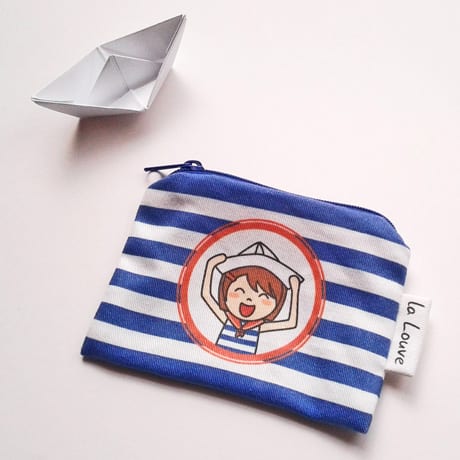

It’s more of a shared purse than a safe
Professional skippers never charge their crew members more than the kitty. It’s a legal obligation of their job.
However, many sailing boat owners think it’s absolutely fine to make passing crewmates (boat-hitchhikers) contribute to the boat maintenance costs on top of the kitty. Just so we’re clear, they charge you for the trip.
If you directly approach sailing boats in marinas, you’ll sometimes be asked how much you’re willing to pay (that is, in addition to the kitty).
Most boat-hitchhikers are travellers on a tight budget and they’re not willing to pay this extra contribution. Owners know this. Even so, on forums, you can read a number of testimonies from boat owners who are offended that boat-hitchhikers refuse to pay more than the kitty.
Those who are willing to pay more are therefore much more likely to find a boat to board. But the trip is way much more expensive and can you really call it boat-hitchhiking?
We know that a good number of boat-hitchhikers are looking to sail across the Atlantic. From the UK to the Caribbean, you need to budget around £250 – £350 ($350 – $450). We’ll tell you more about this in the “Atlantic Crossing” chapter..
You can find a boat to board without any experience related to the sea. In fact, certain everyday qualities and skills are just as, if not more useful, on a sailing boat. The following paragraphs list everything that a skipper looks for in a crew member. Nobody requires a crew member to tick all the boxes, even if some are very important.
On a sailing boat, space is limited. The smooth operation of the boat is based on teamwork. And, above all, you can’t just get off at any moment. Ocean crossings take several weeks. The most important thing is that everyone gets along well together.
Serious communication problems and disagreements on a boat can turn life on board into a real nightmare.
A good teammate should get along well with the rest of the crew. It’s essential to be sociable and good-humoured. Once at sea, know how to deal with difficult people, without adding another one to the mix. You have to be able to smooth things over and be open-minded, in short, you need to have excellent interpersonal skills.


On a sailing boat, try using nonviolent communication
It’s possible to get on board with very little or even no sailing experience.
You can board sailing boats with either very little or even no sailing experience at all. In fact, this is the case for most boat-hitchhikers. The tasks given to an inexperienced crew member are simple (see the chapter, “Crewmate’s Role”) and can be learnt quickly on the job. That said, the more experience you have, the better it is.
Paradoxically, skippers are also wary of experienced crewmates who are likely to overestimate themselves and make misguided decisions or question the skippers’ instructions, and that’s “a big no-no” on a sailing boat. Therefore, it’s advised to mention your experience, but with modesty.
Learning to sail before embarking on a boat-hitchhiking adventure, even if it’s only the basics, is a particularly good idea before a long trip. See the chapter, “Learn How to Sail”.
“Very experienced” crew members are sought after. The skipper is very often the only member of the crew who’s actually capable of running a boat safe and sound. On a long journey, it makes sense for them to take another crew member on board who’s able to replace them in case something serious happens to them.


You don’t need to be a Olympic champion like Sir Ben Ainslie
Tying knots is part of the crewmates job. You can always learn basic knots on the job, but mastering them before you set off is a plus.
There aren’t too many of them and you can easily practise with a bit of string. The animatedknots.com website explains every knot step by step so you can easily learn how to do them. Here are the most useful ones:
Coiling ropes refers to the way ropes are wound so you can put them away neatly and get them out easily. The cockpit should never be obstructed with rope lying around. It’s a question of safety and it also helps to keep them in good condition. So, for a lot of the time, you’ll be coiling. You quickly pick up the twists and turns of the arm, but a little prior practice doesn’t hurt.
Everything on a sailing boat has a specific name. Even left and right are port and starboard.
Learning the basic vocabulary is a great idea, especially as everyone tends to confuse them at first.
These are the most common terms: port, starboard, sheet in, ease off, lower, hoist, luff, bear away, leeward, windward, boom, mainsail, jib, reefing. You’ll find the definition of these sailing terms on the Life of Sailing website.
A boat isn’t just a means of transport. For owners, sailing is still a passion. They’ll only take someone on board who shares this passion or shows interest and curiosity in the sea and the world of sailing.
Luckily, English is one of the best languages for boat-hitchhiking.
However, speaking other languages is a real bonus. If none of the crew members speak the language of the country they’re heading for well enough, taking a boat-hitchhiker on board who has a good level of that particular language will undoubtedly be very helpful.
On arrival in a port, for example, you need to contact the harbour master’s office by radio or talk with the employee in the dinghy who comes to meet the boat. It’s best to avoid communication problems at such times.
Obviously, everyone likes to eat good food.
On a sailing boat, the kitchen space is limited and often modestly equipped: there’s never a freezer, and fresh products are sparse. Sometimes this comes as a bit of a shock.
It goes without saying that knowing how to cook well in these conditions is a real quality.
Back to your recipe books!
By “provision”, we mean “do the shopping”, i.e. stock the boat up with food.
It’s often an underestimated organisational skill that goes hand in hand with that of a cook.
It’s not so easy managing the needs and wants of everyone, as well as the quantities of food necessary to go with planned menus, all while staying within the set budget. If you forget the butter, you can’t do a U-turn and sometimes you won’t find the next shop for several weeks.
Having fresh bread right in the middle of the ocean was just crazy!Kris
“Real bread” keeps for a while, but after that you’ll quickly have to switch to sad sliced bread, which doesn’t always keep that well either. This is what happens during a long crossing – any restocking is out of the question.
Those who know how to make bread in a small boat gas oven are likely to be considered a real everyday hero.
Doing your shifts, and especially your watchkeeping shifts at night, is the main role of a crewmate.
At night, you need to get up on time to take over from the person on the previous shift. It’s important to avoid dawdling before you start watchkeeping. Lacking punctuality in this area means delaying your crew members’ sleep.
And what’s more, it’s out of the question to be distracted, or worse, sleep on the deck. You must take this role very seriously, safety and everyone’s lives are at stake.
There’s never a shortage of opportunities to DIY on a sailing boat.
First of all, a crewmate with mechanical skills will be extremely valuable as they can understand and repair a potential engine failure.
Then, everyday DIY skills are also very useful so you can anticipate problems and fix broken things.
During his Atlantic crossing, Kris had the opportunity to repair loose hinges, unblock clogged up toilets, retighten loose lifelines, clear a net stuck in the propeller, change a cracked hose on a gas cylinder, etc.
Skipjack, tuna, sea bream, mackerel, wolffish, pollock, kingfish… Eating the fish you catch is truly one of the great pleasures of sailing.
A trolling expert can really make themselves useful on board. Of course, it’s also essential to know how to prepare the fish.
Here’s an article to learn the trolling basics.
An accident on a boat can turn nasty. Far away from coasts, you can only rely on the crew.
There’s always a complete first aid kit on board, but you still have to know how to use it.
Having someone on board who knows first aid is already a plus. Having a doctor or a nurse is invaluable.
When you’re seasick, you’re good for nothing, drained of all your strength. You can be more or less prone to it. Generally speaking, after four or five days at sea, you no longer get seasick. Some, though they’re few and far between, never really find their sea legs. For them, sailing is a nightmare.
Before undertaking a long crossing, it’s a good idea to do some sailing to be sure that you’re not one of them.
As a rule of thumb, if you already suffer from motion sickness in cars or on buses, it’s likely that you’ll also get seasick.
We talk about seasickness in more detail and ways to avoid it in the chapter, “Dangers and Safety at Sea”.
There isn’t much space on a boat. You can’t spread yourself out in a disorderly way, especially in communal areas.
It’s not only a question of comfort, but also of safety. Particularly when the sea conditions are tough and the boat is heeling. You definitely shouldn’t risk a bottle spilling or slipping on an object that’s fallen to the ground. You can’t waste a second looking for a pencil, a compass, a map, a piece of clothing or worse, a life jacket. The deck should always be clear so that it can be used for navigation.
Avoiding this wasted time is all the more important as staying indoors too long can make you seasick.
Obviously, that’s the least you can do.
Smokers aren’t usually accepted on board, especially as the smell of tobacco tends to cause seasickness.
Smoking cannabis is generally frowned upon. It’s an obvious source of distraction. Safety is a constant concern on a boat. It’s not the appropriate place for this type of indulgence.
We’ve said it before, and we’ll say it again, apart from big catamarans, sailing boats have limited space. Looking to board a ship with a suitcase or a bike is a drawback. It’s better to travel relatively light.
The necessary gear on a boat varies depending on the conditions. What’s certain is that you need waterproof clothing.
With a budget of around $70 (£50) to $90 (£70), you can equip yourself with the bare minimum. This’ll be suitable for short journeys, if the weather’s warm and the sea conditions are favourable.
For long journeys, it’s better to be well kitted out. However, since they’re mainly done in the tropics or during hot periods, you rarely wear heavy jackets. Not having one won’t usually be an obstacle when looking for a boat to board. Proper sailor gear isn’t easy to lug around. It’s heavy, bulky and expensive. But, if you do invest in it, you can always send it back by post once you’ve finished travelling at sea.
If you don’t want to or can’t get them, with a little luck, you can hope that the skipper or another crew member will lend you some spare sailing clothing. Whoever goes to sleep won’t need them and will probably let you borrow theirs, at least when it comes to night shifts.


Kris all nice and dry in his sailing jacket en route to the Canary Islands
Many websites put skippers and crewmates in contact. On these websites, you can find adverts from both owners and professional skippers (who are transporting and delivering other people’s boats).
You can put an advert on there or respond to sailing crew opportunities. On some websites, you can even find paid job offers, they’re usually on luxury motor yachts.
It’s nothing to do with dating websites. Nonetheless, some single owners and sailors also use these websites for that reason. The likelihood of such a nasty surprise is pretty low, and when it is, the ad is very clear, so just don’t bother responding to it.
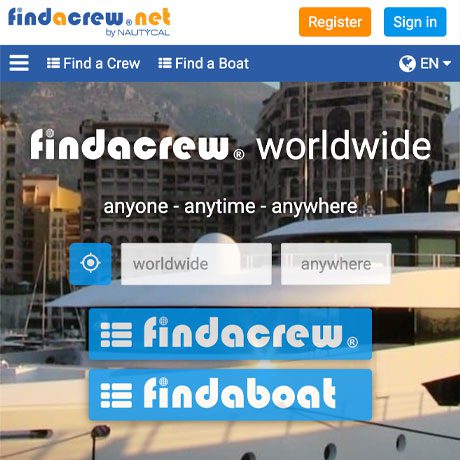

Findacrew website: the biggest one
Sailing boat delivery skippers (professional skippers) are most often self-employed, directly hired by individuals or shipowners. They have their own personal website. A simple search on a search engine, using the terms “sailing boat delivery skipper”, will help you find dozens of them. There are also a few companies (relatively difficult to find on the internet) that also transport and deliver sailing boats. They group several skippers together and subsequently do many more sailing boat deliveries. It’s better to target these companies before anything else to have a better chance of finding a boat.
On these websites, you won’t find sailing crew opportunities with a specific date and place of departure and arrival. However, professional transporters are theoretically open to speculative applications. If an application interests them, they’ll make an offer.
This method is more risky. It’s better to be open to any route, with very flexible dates. However, you can land a crew opportunity by beating the competition to the punch, before the skippers even decide to look for a crewmate in their network or place an ad on a crew exchange website.
Here are some sailing boat delivery companies: OceanTrax, HalcyonYachts, YachtDeliveryCompany, PacificYachtDelivery, SevenSeasYachtDelivery and DeliveryCaptain.
Skippers looking for crewmates know well in advance when and where they’re going to need them. Some rely on website ads. Others know that they’ll stopover in busy ports where there’ll be lots of boat-hitchhikers, and prefer to find them there. Finally, some aren’t really looking for crewmates and it’s only after meeting them that they decide to take them on board. So, looking locally in person also works pretty well, in addition to online research.
Florence, a traveller with years of boat-hitchhiking experience under her belt, told us that she found more than half of her crew offers in person.
One of the main, and perhaps the most important criteria for a successful sailing trip, is that all the crew get along well. Looking for a sailing crew opportunity directly in ports has the huge advantage of meeting skippers in the flesh. It’s always much easier to gauge a situation in person than it is over emails and phone calls. And also, in this way, you can see the boat that you might board, with your own eyes. You can make sure it’s in good nick and properly kitted out.
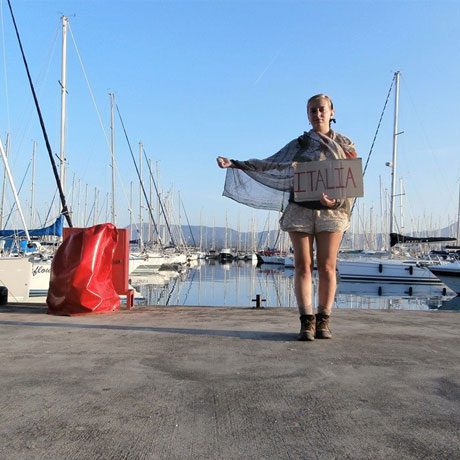

A boat-hitchhiker at a port in Greece
Get yourself to the marina. Departing boats will most likely be at the visitor pontoons. Go up to the sailing boats, and hope to find the crew on the deck of the boat. Start a conversation, introduce yourself and explain your travel plans, and hope that the people on board are looking for a crewmate. The initial contact is tricky, and it’s not easy for shy people. There isn’t a recipe for success. It’s important to be smiley, seem friendly, and perhaps ask if they want to grab a coffee or beer so you can get to know each other better.
Since you’ll probably have to spend some time around the sailing boats, you might as well spend this time making yourself useful. Word of mouth might get the message out that a nice, helpful person (you) is looking to board as a crew member. So don’t hesitate to help out if you can or if the opportunity presents itself. You could, for example, help with mooring, loading shopping on board, translating during port entry procedures, etc.
Be careful, sailors are not only looking for friendly crewmates, but also serious ones. Many are wary of young hippie-like people who are sometimes (mis)taken for joint smokers and slackers. You should pay a little more attention to your appearance so you’re not put in a box at first glance.
Sometimes, pontoon entrances are closed with a coded gate. So you have to take advantage of someone going through to be able to get through yourself. What’s more, sometimes the boats are also moored to a buoy and therefore aren’t directly accessible. Therefore you need to borrow a dinghy from a kind person or, if it’s possible, go and meet the boats directly by swimming. Bars in the marina are also a good meeting place.
You need to be persistent. You’ll have to come back day after day to meet everyone and make yourself known. This could take a few days or several weeks.
You also need to make sure you have a hard-copy of your ad and hand it out as widely as possible, starting with notice boards and bars in the port. Later in this article we’ll explain how to write a good ad.
Jimmy Cornell reckons that there are around 8,000 sailing boats currently on a long trip on seas around the world, which isn’t a lot. So you have to be in the right place if you hope to board one of them. For this, it’s best to have some idea of popular sea routes and know the best departure ports on them for the destination you have in mind.
Once you’ve chosen the right departure port, you still need to be there at the right time. Prevailing winds and currents change with the seasons. From one year to the next, in the same season and in the same month, similar conditions can be expected. Sailors plan their trips so as to navigate during the most favourable periods and avoid hurricane seasons at all costs.
For example, Las Palmas de Canary Islands is a real global hub for long-distance sailing boats. Most boats headed for the Caribbean stop there between September and January.
In the chapter, “Boats: Where and When to Find Them”, you’ll find a list of popular hubs on the most travelled sea routes and a table of the best departure times for different sea routes.
Even more so than for hitchhiking, you’re open to more opportunities if you choose to get on a boat that doesn’t necessarily go to the end point that you’d originally had in mind. Instead, board a boat that edges its way to the final destination and that stops in a port which allows you to boat-hitchhike a little further and a little longer.
A good ad should include:


A nice but unsuccessful ad pinned up in the Canary Islands
When researching for this article, some boat-hitchhikers we interviewed told us that they created and uploaded a playful video with the aim of introducing themselves to people likely to take them on board. This is such a great idea. They put the link to their video in all of their online ads, as well as their hard-copy ads.
You’ve found someone who’s ready to take you on board. That’s awesome! But be careful, getting on well together isn’t the be-all and end-all.
It’s also important to ensure that it’ll be a safe trip. To do this, you need to find out about the condition of the boat, its equipment and figure out how sensible the skipper is.
Here are some safety measures you should take, as well as some rather delicate questions to ask tactfully so as not to offend the pride of the person you’re speaking to, who undoubtedly has much more experience than you.
Below is a map from Jimmy Cornell’s website. You can see some popular ports which are located on the routes most travelled by long-distance sailing boats. The figures show the number of sailing boats that stopped there in 2015.




A novice probably thinks that a boat can go anywhere and that you’re therefore likely to find them almost everywhere.
In fact, there are several factors that make long-term skippers follow major shipping routes. These mainly include tourist attractions, number and quality of ports, safety of countries, but, above all, sea and wind conditions. Certain areas in the world, like the south-west coast of Africa, are almost completely neglected. Many trips are only one way.
On the map above, you can see the most popular routes taken by long-distance sailing boats. The likelihood of finding a crew opportunity outside of these major routes is limited.
Jimmy Cornell describes the movements of long-distance sailing boats more accurately in his great article, “Where Do All the Boats Go?”.
| Towards | Best time |
|---|---|
| From Europe | |
| Europe (from the atlantic) > The Mediterranean | June – August |
| From North and West Africa | |
| The Canary Islands > The Caribbean | End of November – February |
| Cape Verde > The Lesser Antilles | December – April |
| Cape Verde > Brazil (north) | November – May |
| From North America | |
| North America (east) > The Caribbean (east) | End of November, April – May |
| North America (east) > Europe | May – June |
| California > Hawaii | April – May, October – November |
| California > Central America | December – April |
| Florida > Panama | End of Nov – December, April – May |
| From Central America | |
| The Galapagos Islands > Polynesia | March – May |
| Panama > The Marquesas Islands | April – June |
| Panama > The United States (west coast) | March – May |
| The Caribbean (east) > Brazil | November – February |
| The Caribbean > The Azores > Europe | May – June |
| From South America (East Coast) | |
| Brazil > The Lesser Antilles > Europe | January – May |
| Brazil > The Azores > Europe | April – June |
| Brazil, Argentina > South Africa | October – January |
| From South America (West Coast) | |
| Chile > Central America | November – May |
| Ecuador > The Galapagos Islands, Polynesia | End of March – May |
| Easter Island > Polynesia | February – May |
| From Africa (East Coast) | |
| South Africa > Brazil | December – March |
| From Southeast Asia | |
| Thailand, Malaysia > Sri Lanka | January – February |
| Bali > Sri Lanka | August |
| Singapore > Bali > Australia (Darwin) | April, September – October |
| Sri Lanka > Thailand, Malaysia | January – February, August |
| Sri Lanka > The Maldives | January – February |
| Sri Lanka > The Red Sea > The Mediterranean | January – February |
| From Australia and New Zealand | |
| Australia (Brisbane, Sydney) > New Caledonia, Vanuatu, Fiji | May – June |
| Australia, New Zealand > Polynesia | May, October |
| Australia > New Zealand | May, October |
| Australia (east coast) > Indonesia | July – October |
| New Zealand > Australia | April – June |
The word “hurricane” is used in the Atlantic Ocean and the Northeast Pacific, “cyclone” in the Indian Ocean and the Southern Pacific Ocean and “typhoon” in the Pacific Northwest. It is in fact the same phenomenon, that is, extremely violent storms with wind speeds greater than 64 knots, or more than 100 km/h (60 mph).
Ending up in the middle of such a storm is beyond dangerous. No sailing boat would risk it. So you won’t find a single boat departing from these places during the seasons where these phenomena are likely.
Travel time at sea varies a lot and depends on many factors: wind direction and strength, as well as the sailing boat’s performance.
Nonetheless, without actually knowing these factors, you can still roughly try to estimate the amount of time it’ll take. In average conditions, the average speed of an average sailing boat is around five knots per hour (6 mph or 9 km/h).
So, all you have to do is measure the distance as the crow flies by using the website distance.to. Divide it by six (or nine) and ta-da!
For long journeys, sailors generally manage to set off under optimal conditions, so the distance should be divided by six or seven knots (7 mph to 8mph or 11 to 13 km/h).
However, the journey is rarely a straight line. You often have to travel a long distance in one direction to get favourable winds. When you’re a beginner, the only real way to estimate the travel time is to ask sailors who know how to do it.
In the chapters, “The Transatlantic Crossing” and “The Transpacific Crossing”, you’ll find, amongst other information, how long these crossings take.
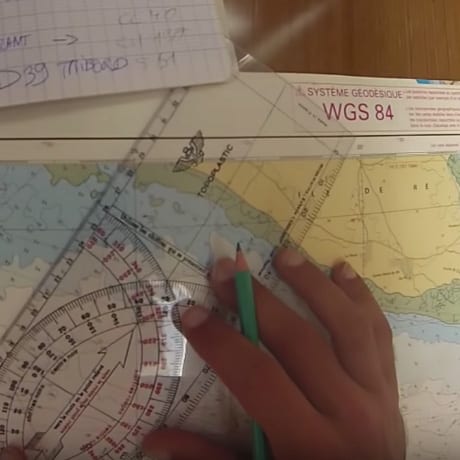

Calculating your route and speed the old-fashioned way
The least we can say is that seasickness is very unpleasant. Severe seasickness makes you vomit so many times that it completely exhausts anyone. You can’t keep anything down and you’re unable to do anything.
Technically speaking, seasickness is caused by the conflict between the different information sent to the brain about your position, stability and balance, in particular, that which is recorded by the inner ear and the eyes.
Mild seasickness goes away by staying outside, staring at the horizon or taking the helm. To get rid of severe seasickness, you need to lie down and close your eyes. There’s relatively effective medication to help prevent seasickness. The best ones are “Bonine” (US) and “Kwells” (UK). As a precaution, we advise you to always take some. There are also anti-motion sickness glasses, but they don’t exactly work miracles.
During the first few days at sea, you’re always more likely to get seasick. Then you become much less sensitive to it. You find your sea legs.
Seasickness can always come back if the factors that cause seasickness are there. For many, this includes cold, hunger, fatigue and fear.
To reduce the risk of having seasickness, you therefore need to think about drinking and eating sufficiently, wrapping up warm and believing in yourself, the crew and the boat’s ability to face rough sea conditions. You should also avoid spending too much time standing inside the boat.
In actual fact, seasickness isn’t something that you do or don’t have. Everyone gets seasick from time to time. Only a very few hypersensitive people have systematic, persistent seasickness and never become accustomed to life at sea. To be sure that you’re not one of them, there’s nothing better than getting on a boat for a few days to test your seasickness. We advise against embarking on a long journey before having done this test.
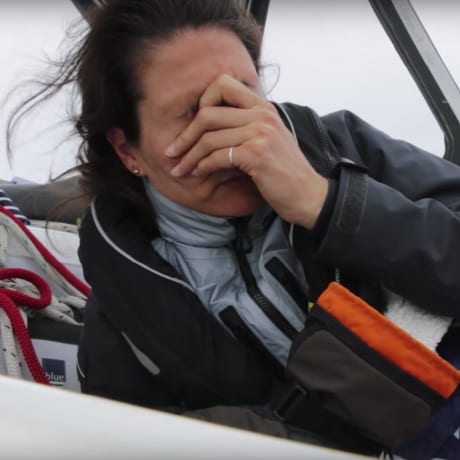

Sophie suffering from seasickness
Even on a well-maintained boat, although the risk is reduced, things can break. It’s not unusual. Fortunately, generations of sailors have thought long and hard about all the potential problems and have anticipated solutions for them. A sailing boat must be equipped with repair kits and spare parts so you can fix the damage.
All sailing boats must be prepared for this eventuality. In accordance with the law, complete and very specific safety equipment must be on board and certified.
For example, high-sea navigation sailing boats must always have a lifeboat, a survival kit, a fixed VHF radio and another transportable radio with a range of about 30 miles (50 km), an emergency position-indicating radio beacon, etc. What’s more, although it’s not mandatory, most sailing boats that cross oceans are also equipped with a satellite telephone. This lets you download weather files and reach emergency services, even in the middle of the ocean. It’s expensive, but really reassuring!
At sea, you have a duty to assist a boat in distress which is within range. In the middle of the ocean, you can therefore hope to be rescued by another sailing boat or, what’s more likely, by a cargo ship. Closer to the coast, it’s likely that maritime rescue services will be the first to respond.


Great, a satellite telephone that looks like an old Nokia
Recovering a man overboard is a tricky procedure. The risk of death is heightened as soon as the weather turns.
Any skipper is trained for this eventuality and the crew should be briefed prior to departure on their specific role in case it happens.
Crew always do their best to prevent this accident, but sometimes it occurs, and it’s almost always due to negligence. Therefore, there are clear safety rules to stick to.
Sailing boats are equipped with a safety line, and also a “lifeline”. This is a kind of rope that runs all around the boat and that you can clip a tether to that’s connected to your life jacket. With this system, there’s no more danger of falling. You’re personally attached to the boat. It’s vital to clip yourself on as soon as the conditions pose the tiniest risk.
The law is very protective towards crewmates and much harsher towards skippers. They have a legal responsibility. If there’s an accident and it’s proven that they haven’t done everything to ensure the safety of everyone on board, even if they’re not directly to blame, they can be convicted of a serious crime. This explains the strict hierarchy aboard a sailing boat. You must obey the skipper’s orders without question, especially those concerning safety.
Special insurance isn’t necessary to be a crew member. Normal travel insurance is enough. Boat insurance includes third party liability which also covers the crew members, particularly with regards to search and rescue fees, repatriation and medical aid.
If you plan on arriving in a country by sea, for a crew member, administratively, it isn’t much different from arriving by plane or a land border. Therefore, before departure, you have to make sure that everything’s in order.
Here are the few specific factors to take into consideration:
Around one month from the UK. Two weeks from the Canary Islands. A few days less from Cape Verde. Around 25 days from South Africa.
You can find a boat to board where you only have to pay the kitty. A transatlantic crossing takes around one month from the UK. At a rate of £5 to £10 per day, you therefore need to have £150 to £250.
From the UK, the ideal departure period for a transatlantic crossing is between November and February. Less and less sailing boats start the crossing as February approaches.
From South Africa, the start of January is the best month.
For the trip back, from the Caribbean, the best departure months are May and June.
The hurricane season in the North Atlantic between June and November should definitely be avoided.
The transatlantic crossing to Brazil doesn’t go through areas at risk of hurricanes. So the crossing can be done all year round.
Towards the Caribbean, your best bet is to find a boarding straight from the UK to your arrival destination by looking on crew exchange websites.
The other option is to go to Las Palmas de Canary Islands first, then find another boarding out there if necessary. But be careful, on the spot like that, the competition is tough. It’s the boat-hitchhiker capital of the world. There are dozens of them there during peak season. You might be looking for several weeks, during which time you need to find accommodation and food, which isn’t free.
Another option is to get as far as Cape Verde where other boats, less of them, leave for Brazil and the Caribbean. In exchange, there’s a lot less competition with other boat-hitchhikers and life out there is cheaper.
Finally, there are some sailing boats, although even fewer than elsewhere, that come from the Indian Ocean and leave from South Africa, mainly from the city of Cape Town. The transatlantic journey is harder and longer from there.
On the journey back (or the journey there for Americans) towards Europe, departures are from the Lesser Antilles, in particular, Trinidad and Antigua. There are far fewer candidates on the return journey, so finding a boarding is much easier.


Crossing an ocean inevitably conjures up images from disaster films and end-of-the-world storms. In reality, the transatlantic crossing, undertaken in the right season, is considered a relatively easy and peaceful crossing.
On the transatlantic passage, most sailing boats are going to the Caribbean, whilst most of the others are going to Brazil.
In any case, the route goes through the Canary Islands. It takes around ten days from the UK. From there, to reach the Lesser Antilles, the Atlantic crossing takes almost 20 days.
The first part of the trip crosses the Bay of Biscay, known to be a difficult passage. After the Canary Islands, trade winds push sailing boats to the finish. The sailing boat doesn’t heel, the wind is blowing from the stern (behind) so you can barely feel it. The waves, although often high, are long and spaced out, so the journey is comfortable and very little manoeuvring is expected.
After the Canary Islands, a few sailing boats choose to continue to Cape Verde, from where they cross to Northern Brazil or the West Indies.
The journey from Cape Verde to the West Indies is similar to that from the Canary Islands. It’s just a little shorter.
South African sailing boats and those coming from the Indian Ocean never sail north, which is deemed to be dangerous and doesn’t have a decent port. Every year, around 200 boats therefore cross the Atlantic from Cape Town. After around ten days, Saint Helena island is an unmissable port of call. Then, most boats head towards Salvador de Bahia, Brazil, which takes another 15 days or so. From there, they continue to the Caribbean. Only a handful head directly for the Caribbean or travel to Southern Brazil and Argentina (those who intend to go past Cape Horn).
The route to Europe is different from the route from Europe. The maritime route starts the transatlantic crossing in the West Indies. The route climbs north before branching off to the east. There’s always a stopover in the Azores before finishing the trip.
It’s a less comfortable crossing, with less favourable winds and you go from a tropical climate to a colder climate. There are far fewer candidates who travel in this direction. Therefore, finding a boarding is much easier.
Many crew members have told their transatlantic story online. To get a good idea of what it’s really about, there’s nothing better than reading their real life stories and watching their videos.
Le reportage hyper sympa en dix vidéos de la transatlantique retour de Capitaine Rémi dont on vous met le premier épisode ici :
La transat de Loic et de ses amis :
From Panama City.
From January to April.
Four weeks (excluding stopovers) to Polynesia.
$450 to $650 (£350 to £500) or more with a stopover at the pricey Galapagos Islands.


The Pacific Ocean is a lot bigger than the Atlantic Ocean. Looking at a map, you can see lots of islands and you might think that there are many possible routes. In reality, the vast majority of sailing boats follow roughly the same route. And that’s the simplest one, given the difficulties, distances and ease of stopovers.
In the vast majority of cases, the crossing is done from east to west, as the crossing from west to east is very difficult. Therefore, sailing boats usually take several years to sail across the Pacific, from east to west, without turning back, then undertaking a Trans Indian Ocean Route.
The Pacific Ocean is also far away from Europe. For that reason, there are fewer sailing boats that attempt this crossing, in comparison to the Atlantic one. And subsequently, there are less opportunities for boat-hitchhiking. Fortunately, for boat-hitchhikers, the starting point is very clear: it’s Panama City and almost all boats leave during the same period.
Don’t rely on boat-hitchhiking if you want to go to Easter Island and then New Zealand. It’s extremely rare for sailing boats to take this route, especially as the port is so poorly sheltered that it’s advised to leave someone on board at all times. This doesn’t make tourism easier.
Departure is from Panama City between January and April with a peak in February. Some sailing boats make a direct trip to French Polynesia, but most head to the Galapagos Islands first, despite the steep cost of the stopover. From there, the journey continues directly to French Polynesia.
If you go directly from Panama City to the Marquesas Islands (the easternmost archipelago of French Polynesia) it takes around four to five weeks. From Panama City to the Galapagos Islands, it takes about a week. The real crossing begins between the Galapagos Islands and the Marquesas Islands. The distance is nearly 3,000 nautical miles, or more than 3,000 miles (5,500 km). It takes over three weeks without touching land.
There are several viable options from French Polynesia. Most sailing boats set off for Australia, then on to the Torres Strait, between Australia and Papua. Many head for New Zealand, and then southern Australia. There are many archipelagos on the route: Cook Islands, Tonga, Fiji, Vanuatu, New Caledonia…
Sailing boats that get this far want to make the most of it. So, they usually continue westward, making several, sometimes long, stopovers.
A boat-hitchhiker will therefore have trouble finding a boat that intends to make a direct journey. Consequently, boat-hitchhikers end up taking several rides on different sailing boats from island to island. The distances between them can add up to hundreds of kilometres, often more than a thousand. So these are fairly long crossings that take at least three or four days.
A lot of sailing boats leave around the same time, during the right season from Panama City, so they cross paths and know each other. Word of mouth can work pretty well and a skipper may have heard of you and be more likely to take you on board.
Kiwi couple, lots of sailing videos including a pacific ocean crossing:
American family, 3 part series crossing the Pacific:
The Cruising Kiwis, Kiwi family who live on a sailing boat and sailed across the Pacific Ocean:
As a crewmate, you get the chance to learn how to sail. Firstly, because you need to help with the manoeuvres, but also by asking questions that the skipper will always be happy to answer. However, gaining crewmate experience is neither the most efficient nor the fastest way to learn.
A skipper, as nice as they may be, isn’t a sailing instructor. Their aim is to travel. They won’t pause to make you practice drills nor will they repeat manoeuvres until they’re mastered.
For this, there’s nothing better than taking lessons in a sailing school. In fact, in just one week, you can really learn a lot.
For theory, you can learn it by using the internet or reading books. Taking one in your bag to read on the boat is a great idea.
On crew exchange websites, there are lots of ads for day or weekend trips. Many ads offer regular trips (every weekend).
The aim isn’t to travel, but to practice sailing. This is both for the fun of it and to train and get better.
For those who live by the sea, this is the perfect opportunity to learn how to sail at a low cost, without enrolling in a sailing school.
In a sailing school, you learn by going on day trips, week-long sailing trips where you return to the port each evening, or travelling trips where you sleep on board for one or more weeks.
In the US, the US Sailing – United States Sailing Association is one of the oldest non-profit organizations that offers training and education courses all over the US. They cater to a variety of levels, from total beginners to experienced instructors. Their find a school / course tool will help you find exactly what you’re looking for. Prices vary depending on the location and the type of course, but a 32 hour course in Northern California costs around $750.
Other well-known sailing organisations founded in America are IYT – International Yacht Training and ASA – American Sailing Association. Both have sailing schools worldwide that give you the experience and knowledge to sail confidently and safely.
In the UK, the RYA – Royal Yachting Association is the longest-standing and most popular governing body for sailing. They offer all sorts of courses for children, adults and disabled people. They have beginner, intermediate and advanced practical and theory courses that help you gain experience, skills and knowledge. Use their course finder to find the right training course for you, or type in a particular location to find a club or centre near you. The five-day long RYA Day Skipper Sailing Practical Course costs between £400 (low season) to £900 (high season).
Some smaller, yet reputed, British sailing schools include Elite Sailing based in Kent, UKSA – United Kingdom Sailing Academy on the Isle of Wight, Hamble School of Yachting and First Class Sailing Ltd. both in Southampton, Devon Sailing Experiences in Plymouth, Nomad Sailing in London and Go West Sailing in Scotland.
The RYA have an extensive selection of books, eBooks and audiobooks on everything and anything sailing-related, from basic crew skills to weather handbooks. US Sailing has a similar range of books.
The ASA’s “Sailing Made Easy” is a comprehensive textbook complete with illustrations, photos and quizzes. It also has a glossary which is particularly useful for brushing up on, and testing, your nautical terminology.
“The Complete Sailing Manual” is written by the experienced British sailor, Steve Sleight, and the latest edition (fifth) has a foreword by Sir Ben Ainslie. It covers all aspects of sailing, from navigation to repairs, and includes detailed diagrams and awe-inspiring photography.
Two US sailing champions, J.J. Isler and Peter Isler, have compiled the essentials of sailing in, “Sailing For Dummies, Third Edition”. All the key information is presented in a way that’s accessible for complete beginners and will give you the confidence boost you need to get on board!


The Complete Sailing Manual

